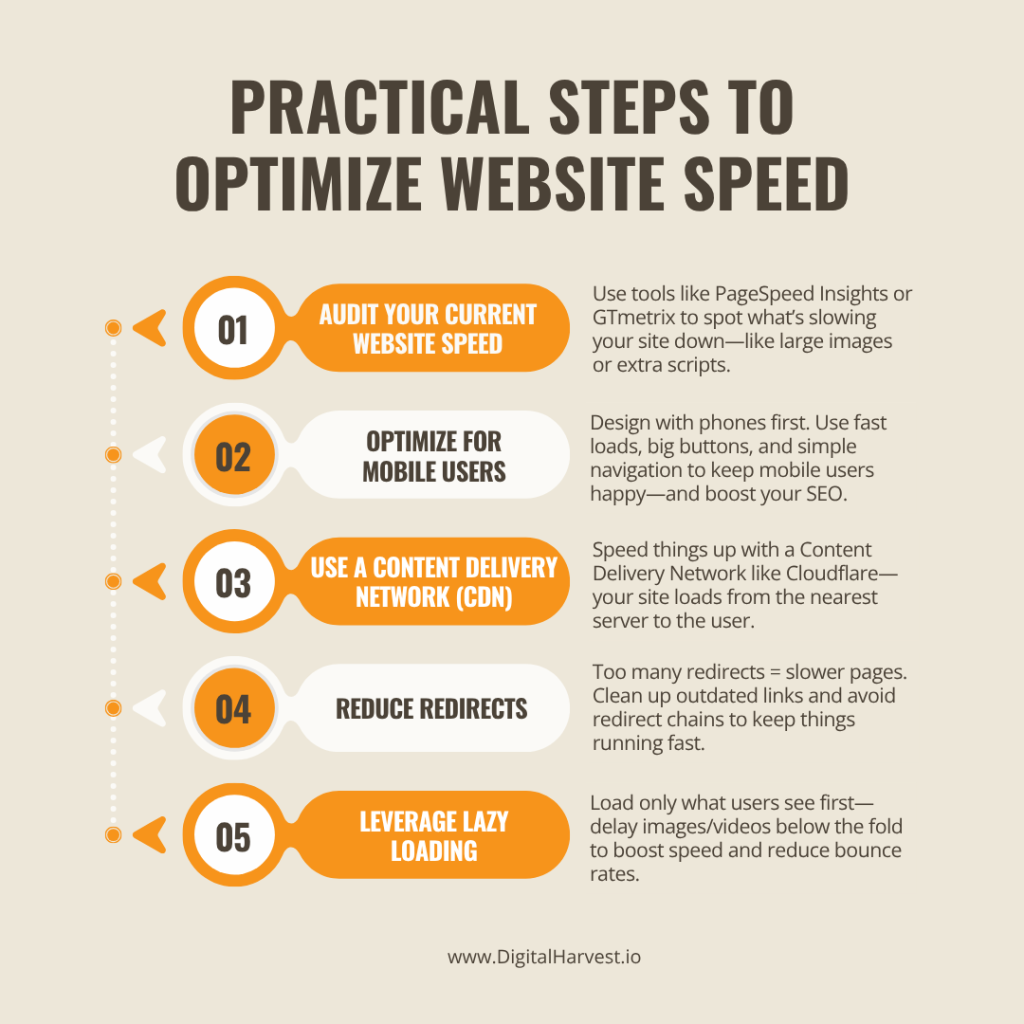How to Optimize Your Website for Speed and SEO
47% of online users expect a website to load in 2 seconds or less. A slow website isn’t just inconvenient—it actively drives customers away. For home service businesses, this can mean fewer calls, fewer leads, and missed opportunities to convert potential customers.
Your website speed matters. It directly influences your user experience, bounce rate, and—most importantly—your SEO rankings. Search engines like Google care about speed because your customers do too.
This blog will walk you through actionable tips to optimize your website for speed and better search engine visibility, catered specifically to home service businesses like yours. By the end, you’ll have the tools to turn your site into a fast-loading, SEO-friendly powerhouse that drives results.
Understanding the Impact of Website Speed on SEO
Why Google Prioritizes Speed
Google emphasizes website speed because it directly impacts the user experience. This is where Core Web Vitals come into play.
These performance metrics include:
- Largest Contentful Paint (LCP): Measures the loading speed of the largest piece of content, like an image or heading.
- First Input Delay (FID): Tracks how quickly your site responds to user interactions.
- Cumulative Layout Shift (CLS): Monitors visual stability during the loading process.
Together, these metrics help Google determine how user-friendly and performance-driven your site is, influencing your SEO ranking.
How Slow Load Times Hurt User Engagement
A slow website can lose customer interest before they even get a chance to explore. High bounce rates—when visitors leave after viewing just one page—are often caused by long load times. This signals to search engines that your site isn’t providing a satisfying user experience, which can lead to lower rankings.
For home service businesses, every second counts. Faster load times don’t just keep customers engaged—they can mean the difference between a lost opportunity and a new client. Think of your website speed as the foundation for solid user engagement and SEO success.
“A 1-second delay in page load time can lead to a 7% drop in conversions. Website speed directly impacts your bottom line. Don’t let a slow site cost you customers.” – Avram Gonzales, Founder of Digital Harvest

Key Factors That Influence Website Speed
When it comes to website speed, a few key factors can make all the difference. By understanding and optimizing these areas, you can ensure your site performs at its best, keeping visitors engaged and helping your business thrive.
Hosting and Server Performance
The type of hosting you choose plays a crucial role in your website’s speed.
While budget-friendly, shared hosting means your site competes for resources with many others on the same server. This can lead to slower load times, especially during traffic spikes. On the other hand, dedicated hosting provides exclusive server resources, offering better performance and scalability for growing businesses.
For home service companies that can’t afford downtime or delays, investing in a reliable hosting provider is essential to maintaining a fast and dependable website.
Image Optimization
Images are often the largest files on a webpage; if they aren’t optimized, they can significantly slow your site. Compressing images reduces their size without sacrificing visual quality, which helps pages load faster.
Tools like TinyPNG and ImageOptim make it easy to optimize images in bulk. Resizing and compressing high-resolution photos of your team or completed projects can create a faster user experience while still looking professional.
Minify CSS, JavaScript, and HTML
Minification reduces the size of your website’s code by removing unnecessary spaces, comments, and characters. This streamlined code improves load times and makes your site function more efficiently.
Tools like UglifyJS and CSSNano can simplify the minification process for developers. The result? A cleaner, faster site that performs better for users and search engines alike.
Browser Caching
Browser caching allows returning visitors to load your website more quickly by storing key data locally on their devices.
For example, a local HVAC company’s website could cut load times for repeat visitors by enabling browser caching. Their browsers would no longer need to download every single element from scratch, boosting user satisfaction and increasing the likelihood of conversions and repeat business.
By focusing on these core elements of website optimization, you can significantly enhance your site’s speed, creating a seamless and enjoyable experience for your customers.
Practical Steps to Optimize Website Speed
Improving your website’s speed is essential for ensuring it runs smoothly and efficiently. To help you get started, here are five actionable strategies:

1. Audit Your Current Website Speed
Before making changes, it’s essential to understand where your website currently stands. Tools like Google PageSpeed Insights, GTmetrix, and Pingdom can provide valuable insights into performance metrics and highlight areas for improvement.
For example, Google PageSpeed Insights often flags issues like unoptimized images or unused JavaScript, giving you clear action items to address.
2. Optimize for Mobile Users
With a significant portion of online traffic coming from mobile devices, optimizing your website for mobile users is a must. This means adopting mobile-first design principles, where the design process starts with smaller screens and scales up for larger devices.
Additionally, features like large, tappable buttons, streamlined navigation, and fast-loading pages enhance usability and keep mobile visitors engaged. Prioritizing mobile optimization improves user satisfaction and can boost your search engine rankings, as Google prioritizes mobile-friendly sites in its algorithms.
3. Use a Content Delivery Network (CDN)
A Content Delivery Network (CDN) significantly improves website speed by storing copies of your site’s content on servers across the globe. This minimizes latency by ensuring users download data from the server closest to their location.
Popular CDNs like Cloudflare and Akamai can be valuable for businesses targeting a wide audience, offering faster load times no matter where visitors are located.
4. Reduce Redirects
Redirects can slow down your website by forcing additional HTTP requests, adding more time to page loading.
For example, if a user visits “example.com” and is redirected to “www.example.com,” the browser has to make an extra HTTP request to complete the process, increasing load times. This delay might seem small, but when compounded across multiple redirects or for users with slower internet connections, it can lead to noticeable performance issues.
Limiting unnecessary redirects, such as cleaning up outdated links or avoiding redirect chains (where one redirect leads to another), can significantly improve your website’s speed and enhance the overall user experience.
5. Leverage Lazy Loading
Lazy loading is an effective method for prioritizing the content that’s immediately visible to users, delaying the loading of elements like images, videos, or scripts further down the page until they’re needed.
For example, on a plumbing service website, images of customer testimonials or completed project galleries lower on the page (just below the fold) are only loaded when the user scrolls down to view them.
This reduces the initial load time, conserving bandwidth and improving performance, especially for users on slower internet connections.
By ensuring that only essential content is loaded first, lazy loading enhances user experience and helps decrease bounce rates. Visitors can access key information faster without waiting for the entire page to load. It’s particularly beneficial for mobile users, where data efficiency and speed are critical.
Tools and Resources to Improve Website Speed
Optimizing your website’s speed is key for user experience and search rankings. Luckily, there are free tools and plugins to help identify issues and apply fixes. Here are some free tools and top WordPress plugins to get started.
Free Tools for Analysis
- Google PageSpeed Insights: This tool provides detailed performance insights for your website on both mobile and desktop. It suggests optimizations to improve load times and overall speed.
- GTmetrix: GTmetrix offers a comprehensive breakdown of your website’s performance with actionable recommendations to resolve speed and optimization issues.
- Pingdom: Pingdom’s speed test tool examines your site’s load time, reports on bottlenecks, and offers tips to enhance performance.
Plugins for WordPress Users
- WP Rocket: A robust caching plugin that also handles features like file minification and database optimization to speed up your WordPress site.
- Smush: Perfect for image-heavy websites, Smush optimizes and compresses images automatically without compromising quality.
- Autoptimize: This plugin simplifies optimizing CSS, JavaScript, and HTML by aggregating, minifying, and caching them for better speed and efficiency.
Each of these tools and plugins can play a critical role in ensuring your website is fast, efficient, and user-friendly. Combining these resources with regular maintenance can keep your site performing at its best.
Fast Websites Drive Better SEO and Business Growth
A fast website is essential for any home service business looking to grow. Speed impacts everything from your search rankings to user experience and conversion rates.
Start by making small changes like compressing images, enabling caching, and reducing redirects. Over time, these improvements add up, turning your website into a customer-conversion machine.
Ready to optimize your website for speed and SEO? Visit Digital Harvest or find Avram Gonzales on LinkedIn for more insights tailored to your business.
